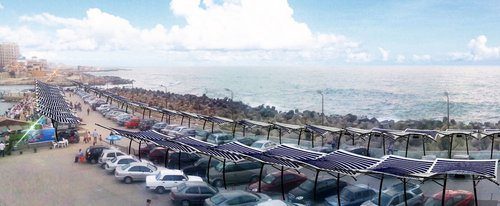
Solar power used to mean large, heavy panels mounted on a roof or spread across a field.
But the sun falls on everyone — and everything — and as materials have gotten lighter, cheaper and more flexible, photovoltaic cells are showing up in the most unlikely of places.
In bustling New York City, you can buy a sandwich at a solar-powered food cart, eat it while sitting at a solar-powered bus stop, all while charging your phone using your solar-powered jacket.
Solar power is becoming more distributed, generating power closer to where it’s needed. That can mean buildings with their own solar arrays, or, on a smaller scale, clothing that features solar panels.
Brooklyn-based solar company Pvilion is leading the charge to put solar everywhere. Their projects range from building covers to small consumer items. “We’re looking at solar as a building material that can be used in a lot of different contexts,” says CEO Colin Touhey.

Touhey and his partners have collaborated with Tommy Hilfiger to make solar-powered jackets, and now they’re working on a line of bags with built-in solar panels. While coats can’t generate nearly as much power as larger arrays, every person with a smartphone is a potential customer.
“It’s really cool to plug in your phone and charge it with the sun,” says Touhey.
Researchers are developing woven solar fabrics that have photoactive dyes coating individual threads, so each fiber is a miniature solar panel. But for now, flexible solar panels must be laminated on top of fabrics.


Integrated solar designs like Pvilion’s awnings and canopies have another cost-saving advantage — they need fewer materials. “The fundamental idea of sustainability is doing more with less,” Touhey says. “If you can span a forty-foot distance with half the amount of weight and produce electricity, that’s a better deal than using a traditional framed structure that might use more materials.”
If you can install a facade that doubles as a solar array, then you can save on labor as well as material costs. It’s the same idea behind Elon Musk’s solar roof tiles, which look like high-end slate, ceramic or glass tiles, but function like photovoltaic panels. According to Musk, his solar roof will cost less than a conventional roof.

Like Tesla’s solar roof, Pvilion’s large-scale projects, like its parking lot canopies, feed surplus electricity into the power grid. Its small-scale projects are designed to work unplugged from the grid.
The firm is working on a new project for the the U.S. Army — a solar-powered robotic tent that can set itself up with the press of a button. Todd Dalland, another of Pvilion’s co-founders, has been designing tents for the Army for decades.
“They’re one of the most interesting tent clients in the world,” Dalland says. “We’re often getting into situations where our buildings are so lightweight they can travel, and here’s one that almost walks!”
Pvilion is just one company dreaming up new applications for solar technology. Other firms are developing transparent photovoltaic cells that could be used in windows or smartphones.
Researchers have even developed solar cells that are thinner than a human hair. As solar costs continue to drop, it’s not hard to imagine a future where almost everything under the sun is powered by the sun.
Source: NexusMedia. Reproduced with permission.










